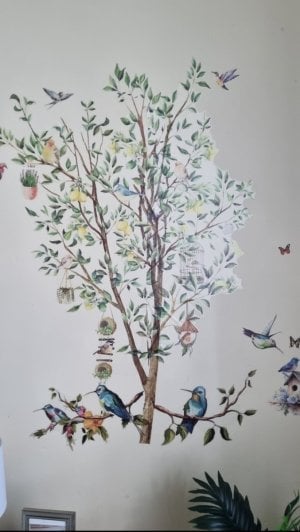Gardeners Beware: The Council’s Latest Crackdown Could Impact Your Backyard Practices!
By
Danielle F.
- Replies 18
In the quest for a greener, more sustainable future, local councils across Australia are taking bold steps to combat the rising issue of urban heat. This phenomenon, characterized by increased temperatures in suburbs with inadequate tree coverage, is a growing concern, particularly in newly developed areas that often lack sufficient greenery. However, these initiatives are not without controversy, as they can significantly impact residents' gardening practices.
One such example is unfolding in the Perth suburb of Bassendean, located in the city's northeast. Here, the local council has introduced stringent new regulations that require homeowners to seek council approval before engaging in any activity that could harm large 'regulated' trees on their property. This policy, which was voted in last month, is part of a broader effort to increase the town's tree canopy to 30 percent by 2040.
The definition of a 'regulated' tree under this new policy is quite specific: any tree that stands over eight meters tall, has an average canopy spread of at least six meters, or a trunk circumference of 1.5 meters falls under this category. 'Tree damaging activities' include actions such as killing, destroying, or removing a tree, as well as severing branches, limbs, stems, or the trunk. Even ringbarking, topping, or lopping of a tree is regulated, according to the council's guidelines.
While the policy does allow for 'maintenance pruning,' meaning property owners can trim trees that overhang onto neighboring properties without needing development approval, the council has also updated its definition of this term. Now, residents can undertake minor maintenance that does not affect the health or general appearance of the tree. Pruning of fruit trees and dealing with dead or diseased trees can also be done without council consent.
The introduction of these regulations has sparked a divide within the community. Some residents view the move as an 'overreach' of authority, while others see it as a 'step in the right direction' towards environmental sustainability. The debate is emblematic of the broader challenges faced by councils as they strive to balance the need for urban development with environmental conservation.
This issue is not unique to Bassendean. Across Australia, councils are setting canopy targets to mitigate the effects of climate change and urbanization. For instance, the Glen Eira City Council in Melbourne has proposed changes to local laws that would require residents to obtain explicit approval before pruning or chopping down canopy trees, with potential fines of $2,000 for non-compliance.
In Sydney, the NSW government has set a goal to increase tree canopy cover across Greater Sydney to 40 percent, up from the current 22 percent. Similarly, the City of Canning in Perth's southeast is working to increase its canopy cover by more than 22 percent over the next two decades, with council staff planting over 5,000 new trees last year. There have also been calls to incentivize residents to nominate trees they wish to be protected.
Back in Bassendean, the new tree policy was proposed earlier this year, with the council inviting residents to share their opinions. Some residents pushed back, arguing for the right to manage their trees as they see fit, while others supported the council's commitment to preserving the town’s existing canopy. Mayor Kathryn Hamilton emphasized the importance of these trees in enhancing streetscapes, reducing the urban heat island effect, and providing habitat for local biodiversity.
As gardeners and homeowners, it's crucial to stay informed about local council regulations that may affect your backyard practices. These policies are often implemented with the intention of fostering a healthier environment for all, but they can also require adjustments to the way we manage our private green spaces. Whether you're a proponent of strict tree protection or an advocate for individual property rights, it's clear that the conversation around urban greenery and sustainability is becoming increasingly important in our communities.

We'd love to hear from our readers at the Seniors Discount Club. How do you feel about these new regulations? Have you experienced similar policies in your area? Share your thoughts and stories in the comments below, and let's discuss the balance between personal freedom and environmental responsibility in our backyards.
One such example is unfolding in the Perth suburb of Bassendean, located in the city's northeast. Here, the local council has introduced stringent new regulations that require homeowners to seek council approval before engaging in any activity that could harm large 'regulated' trees on their property. This policy, which was voted in last month, is part of a broader effort to increase the town's tree canopy to 30 percent by 2040.
The definition of a 'regulated' tree under this new policy is quite specific: any tree that stands over eight meters tall, has an average canopy spread of at least six meters, or a trunk circumference of 1.5 meters falls under this category. 'Tree damaging activities' include actions such as killing, destroying, or removing a tree, as well as severing branches, limbs, stems, or the trunk. Even ringbarking, topping, or lopping of a tree is regulated, according to the council's guidelines.
While the policy does allow for 'maintenance pruning,' meaning property owners can trim trees that overhang onto neighboring properties without needing development approval, the council has also updated its definition of this term. Now, residents can undertake minor maintenance that does not affect the health or general appearance of the tree. Pruning of fruit trees and dealing with dead or diseased trees can also be done without council consent.
The introduction of these regulations has sparked a divide within the community. Some residents view the move as an 'overreach' of authority, while others see it as a 'step in the right direction' towards environmental sustainability. The debate is emblematic of the broader challenges faced by councils as they strive to balance the need for urban development with environmental conservation.
This issue is not unique to Bassendean. Across Australia, councils are setting canopy targets to mitigate the effects of climate change and urbanization. For instance, the Glen Eira City Council in Melbourne has proposed changes to local laws that would require residents to obtain explicit approval before pruning or chopping down canopy trees, with potential fines of $2,000 for non-compliance.
In Sydney, the NSW government has set a goal to increase tree canopy cover across Greater Sydney to 40 percent, up from the current 22 percent. Similarly, the City of Canning in Perth's southeast is working to increase its canopy cover by more than 22 percent over the next two decades, with council staff planting over 5,000 new trees last year. There have also been calls to incentivize residents to nominate trees they wish to be protected.
Back in Bassendean, the new tree policy was proposed earlier this year, with the council inviting residents to share their opinions. Some residents pushed back, arguing for the right to manage their trees as they see fit, while others supported the council's commitment to preserving the town’s existing canopy. Mayor Kathryn Hamilton emphasized the importance of these trees in enhancing streetscapes, reducing the urban heat island effect, and providing habitat for local biodiversity.
As gardeners and homeowners, it's crucial to stay informed about local council regulations that may affect your backyard practices. These policies are often implemented with the intention of fostering a healthier environment for all, but they can also require adjustments to the way we manage our private green spaces. Whether you're a proponent of strict tree protection or an advocate for individual property rights, it's clear that the conversation around urban greenery and sustainability is becoming increasingly important in our communities.
Key Takeaways
- The Bassendean council has introduced new tree protection rules requiring council approval for removing or damaging large 'regulated' trees to increase tree canopy coverage.
- Homeowners face strict policies when engaging in 'tree damaging activities' on 'regulated' trees, which are defined by size and dimension.
- The move has caused division among residents, with some viewing it as an overreach and others as a positive step towards addressing the urban heat issue.
- Australian councils are setting canopy targets to combat climate change effects and urban heat, with some areas increasing enforcement to prevent unauthorised tree removal or damage.












